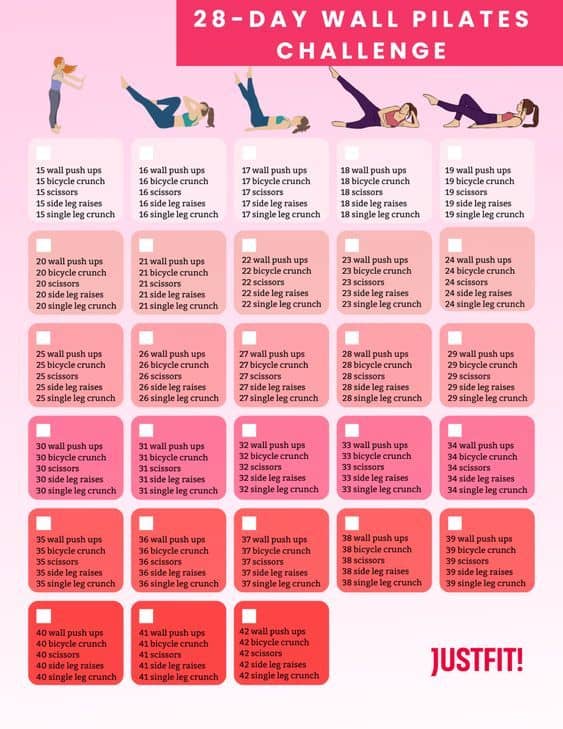28-Day Wall Pilates Challenge: Your Ultimate Guide to Building Strength, Improving Flexibility, and Transforming Your Core
Are you looking for a fun, low-impact, and highly effective way to tone your muscles and strengthen your core? Look no further than wall Pilates! This gentle yet challenging form of exercise blends traditional Pilates principles with the support of a wall, making it suitable for all fitness levels. In this comprehensive guide, we will introduce you to a 28-Day Wall Pilates Challenge that you can do from the comfort of your own home. This challenge ramps up progressively over four weeks, with each day slightly increasing the intensity. By the end of these four weeks, you can expect improved posture, increased flexibility, stronger core muscles, and a new level of confidence in your body’s capabilities.
Before starting, remember to consult a healthcare professional if you have any underlying health conditions or concerns. This challenge is intended for informational purposes only and is not a substitute for professional medical advice. Always listen to your body, go at your own pace, and enjoy the process.
What Is Wall Pilates?
Pilates is an exercise method that focuses on strengthening the core, improving balance, and enhancing flexibility, all while reducing stress on the joints. Traditionally, Pilates exercises can be performed on a mat or specialized equipment such as the Reformer. Wall Pilates adapts these exercises by incorporating the stability and support of a wall.
By pressing your hands, feet, or hips against a wall, you engage stabilizing muscles that help with alignment, balance, and control. This added support can reduce strain and help beginners develop correct form. At the same time, more advanced practitioners can use wall resistance to add complexity, making it an excellent option for anyone looking to diversify their workout routine.
Why Try a 28-Day Wall Pilates Challenge?
- Steady Progression: A 28-day challenge creates a structured schedule, allowing you to see gradual improvements in strength, flexibility, and endurance.
- Low Impact: Pilates movements are gentler on the joints compared to high-impact workouts, making it suitable for individuals with varying fitness levels.
- Time-Efficient: Each day’s workout can be completed in under 20 minutes, perfect for those with busy lifestyles.
- Core-Focused: Pilates is known for its emphasis on core strength, which is the foundation of good posture, better balance, and reduced lower back pain.
- Improved Mind-Body Connection: Pilates encourages conscious movement and controlled breathing, helping you develop a stronger mind-body awareness.
- Long-Term Habit Formation: Consistency is key to seeing results. By committing to 28 days, you’re more likely to turn these exercises into a regular part of your lifestyle.
The 28-Day Wall Pilates Challenge Overview
Each day in this challenge features a specific combination of five exercises. While the repetitions or duration for each exercise gradually increase, the movements themselves remain the same, helping you develop perfect form. The five staple exercises in this challenge include:
- Wall Push-Ups
- Bicycle Crunch
- Scissors
- Side Leg Raises
- Single Leg Crunch
How to Get Started
- Find a Stable Wall: Choose a clear wall space without frames or decorations that might interfere with your movements.
- Wear Comfortable Clothing: Opt for workout clothes that allow full range of motion.
- Warm Up: Spend a few minutes warming up your body. Gentle marching in place, arm circles, and shoulder rolls can help prepare your muscles.
- Maintain a Steady Breathing Pattern: Breathe in through the nose and out through the mouth. In Pilates, the breath helps power your movements and maintain control.
- Stay Hydrated: Always keep water nearby to sip as you need.
- Cool Down: End each workout with light stretching to prevent muscle stiffness.
Below is a detailed breakdown of what you’ll be doing each day. The numbers provided (e.g., 15 wall push-ups, 16 bicycle crunches, etc.) may differ slightly based on your personal fitness level, but this schedule will help guide you through a progressive workload.
Detailed Exercise Descriptions
Before diving into the day-by-day breakdown, let’s explore each exercise in detail to ensure proper form.
1. Wall Push-Ups
- Setup: Stand arm’s length away from the wall, feet hip-width apart.
- Movement: Place your palms on the wall at chest level. Inhale as you bend your elbows and lean toward the wall, keeping your body in a straight line from head to heels. Exhale as you push back to the starting position.
- Muscles Targeted: Chest, shoulders, triceps, core stabilizers.
Pro Tip: Keep your elbows slightly tucked in to protect your shoulder joints, and engage your core to avoid arching the back.
2. Bicycle Crunch
- Setup: Lie on your back on a mat or soft surface. Keep your lower back pressed into the floor.
- Movement: Place your hands behind your head with elbows wide. Lift your shoulders off the floor and bring one knee toward your chest. Rotate your torso to bring the opposite elbow toward that knee. Alternate sides with a “pedaling” motion.
- Muscles Targeted: Rectus abdominis (six-pack muscles), obliques, hip flexors.
Pro Tip: Move slowly and with control. Rather than yanking on your neck, use your abs to lift and rotate your torso.
3. Scissors
- Setup: Lie flat on your back, pressing your lower back gently into the mat.
- Movement: Lift both legs off the floor a few inches (or as high as comfortable) and scissor them up and down. One leg moves toward your head while the other moves toward the floor without touching it.
- Muscles Targeted: Lower abdominals, hip flexors.
Pro Tip: Keep your core braced and your lower back anchored to the floor to avoid discomfort.
4. Side Leg Raises
- Setup: Stand next to a wall with your closest arm gently pressing into the wall for support. Alternatively, you can lie on your side on a mat if you prefer.
- Movement: Lift your outer leg to the side, engaging your glutes and outer thighs. Lower it back down with control.
- Muscles Targeted: Glutes, hip abductors, outer thighs.
Pro Tip: Keep the hips stacked vertically if lying on your side, or ensure they’re level if standing. Avoid leaning excessively into the wall.
5. Single Leg Crunch
- Setup: Lie on your back with your knees bent. Feet can be on the floor or raised slightly.
- Movement: Lift one knee toward your chest as you lift your shoulders off the floor, reaching your arms forward or keeping your fingertips behind your head. Return to the start and alternate legs.
- Muscles Targeted: Upper abdominals, hip flexors, lower abdominals (as stabilizers).
Pro Tip: Exhale as you lift your head, neck, and shoulders, and inhale as you lower back down.
Week 1: Building a Solid Foundation (Days 1-7)
During the first week, focus on mastering form. Since wall Pilates emphasizes control, take your time, move deliberately, and engage your core with every exercise.
Day 1
- 15 Wall Push-Ups
- 15 Bicycle Crunches
- 5 Scissors (per leg)
- 15 Side Leg Raises (per leg)
- 15 Single Leg Crunches (total)
It might feel easy at first, but stay focused on proper alignment. Keep your core tight, your back straight, and remember to breathe deeply.
Day 2
- 16 Wall Push-Ups
- 16 Bicycle Crunches
- 6 Scissors (per leg)
- 16 Side Leg Raises (per leg)
- 16 Single Leg Crunches (total)
A small increase in reps encourages your muscles to adapt. You may begin to feel a slight burn, especially in your core and shoulders.
Day 3
- 17 Wall Push-Ups
- 17 Bicycle Crunches
- 7 Scissors (per leg)
- 17 Side Leg Raises (per leg)
- 17 Single Leg Crunches (total)
Focus on keeping your core engaged. During wall push-ups, do not allow your hips to sag. Use the exhale to power each push away from the wall.
Day 4
- 18 Wall Push-Ups
- 18 Bicycle Crunches
- 8 Scissors (per leg)
- 18 Side Leg Raises (per leg)
- 18 Single Leg Crunches (total)
Add variety by slightly adjusting your stance during wall push-ups or side leg raises, but maintain good form.
Day 5
- 19 Wall Push-Ups
- 19 Bicycle Crunches
- 9 Scissors (per leg)
- 19 Side Leg Raises (per leg)
- 19 Single Leg Crunches (total)
Breathe steadily, exhaling on the effort (push-ups, crunching upward) and inhaling on the release.
Day 6
- 20 Wall Push-Ups
- 20 Bicycle Crunches
- 10 Scissors (per leg)
- 20 Side Leg Raises (per leg)
- 20 Single Leg Crunches (total)
Your endurance is building. Notice if you can maintain better balance and control than when you started.
Day 7
- Rest or Light Active Recovery
- Optional: Gentle yoga, walking, or simple stretches.
Give your body a chance to recover. This day is crucial for muscle repair and mental reset.
Week 2: Gaining Momentum (Days 8-14)
By now, you’ve developed a baseline strength and are ready to push a bit harder. Form is still paramount, and you’ll notice your ability to maintain core stability is improving.
Day 8
- 21 Wall Push-Ups
- 21 Bicycle Crunches
- 11 Scissors (per leg)
- 21 Side Leg Raises (per leg)
- 21 Single Leg Crunches (total)
Day 9
- 22 Wall Push-Ups
- 22 Bicycle Crunches
- 12 Scissors (per leg)
- 22 Side Leg Raises (per leg)
- 22 Single Leg Crunches (total)
As you start to do more reps, you might need mini-breaks between sets. That’s perfectly okay.
Day 10
- 23 Wall Push-Ups
- 23 Bicycle Crunches
- 13 Scissors (per leg)
- 23 Side Leg Raises (per leg)
- 23 Single Leg Crunches (total)
Take note of how steady your pelvis remains during side leg raises. This control indicates core stability.
Day 11
- 24 Wall Push-Ups
- 24 Bicycle Crunches
- 14 Scissors (per leg)
- 24 Side Leg Raises (per leg)
- 24 Single Leg Crunches (total)
You may begin to notice improvements in posture. Standing and sitting upright might feel more natural.
Day 12
- 25 Wall Push-Ups
- 25 Bicycle Crunches
- 15 Scissors (per leg)
- 25 Side Leg Raises (per leg)
- 25 Single Leg Crunches (total)
Day 13
- 26 Wall Push-Ups
- 26 Bicycle Crunches
- 16 Scissors (per leg)
- 26 Side Leg Raises (per leg)
- 26 Single Leg Crunches (total)
You might feel some soreness in your shoulders and core. Make sure you’re fueling your body with balanced nutrition and staying hydrated.
Day 14
- Rest or Light Active Recovery
- Optional: Foam rolling, light walking, or dynamic stretches.
Reward yourself for your hard work and dedication. You have completed two weeks!
Week 3: Pushing Further (Days 15-21)
This week, the reps will continue to increase, challenging your endurance and core stability. Keep your movements controlled and consistent.
Day 15
- 27 Wall Push-Ups
- 27 Bicycle Crunches
- 17 Scissors (per leg)
- 27 Side Leg Raises (per leg)
- 27 Single Leg Crunches (total)
At this point, consider adjusting your feet placement on wall push-ups to increase or decrease difficulty.
Day 16
- 28 Wall Push-Ups
- 28 Bicycle Crunches
- 18 Scissors (per leg)
- 28 Side Leg Raises (per leg)
- 28 Single Leg Crunches (total)
Feel free to pause for a few seconds mid-set if you need it. Quality beats rushing.
Day 17
- 29 Wall Push-Ups
- 29 Bicycle Crunches
- 19 Scissors (per leg)
- 29 Side Leg Raises (per leg)
- 29 Single Leg Crunches (total)
You’ll feel your upper body strength improving as wall push-ups become more fluid.
Day 18
- 30 Wall Push-Ups
- 30 Bicycle Crunches
- 20 Scissors (per leg)
- 30 Side Leg Raises (per leg)
- 30 Single Leg Crunches (total)
Your hip strength will be evident during side leg raises. Keep your chest lifted and body aligned.
Day 19
- 31 Wall Push-Ups
- 31 Bicycle Crunches
- 21 Scissors (per leg)
- 31 Side Leg Raises (per leg)
- 31 Single Leg Crunches (total)
Stay mindful of your breathing. In Pilates, breath control is crucial for core engagement.
Day 20
- 32 Wall Push-Ups
- 32 Bicycle Crunches
- 22 Scissors (per leg)
- 32 Side Leg Raises (per leg)
- 32 Single Leg Crunches (total)
Make sure you’re maintaining proper form. If you feel your posture slipping, take a brief rest and reset.
Day 21
- Rest or Light Active Recovery
Enjoy the calm before the final stretch of the challenge. Stretch out your muscles, focusing on your shoulders, hamstrings, and hips.
Week 4: Final Stretch (Days 22-28)
The final week pushes you to your peak. By now, your core strength should feel significantly improved. Keep your focus as you finish strong.
Day 22
- 33 Wall Push-Ups
- 33 Bicycle Crunches
- 23 Scissors (per leg)
- 33 Side Leg Raises (per leg)
- 33 Single Leg Crunches (total)
Commit to quality over speed. Proper alignment prevents injury and yields better results.
Day 23
- 34 Wall Push-Ups
- 34 Bicycle Crunches
- 24 Scissors (per leg)
- 34 Side Leg Raises (per leg)
- 34 Single Leg Crunches (total)
Feel the engagement through your entire torso during bicycle crunches. Keep your back flat on the floor.
Day 24
- 35 Wall Push-Ups
- 35 Bicycle Crunches
- 25 Scissors (per leg)
- 35 Side Leg Raises (per leg)
- 35 Single Leg Crunches (total)
If you need to break the exercise sets into smaller chunks (e.g., two sets of 17 and 18), do so.
Day 25
- 36 Wall Push-Ups
- 36 Bicycle Crunches
- 26 Scissors (per leg)
- 36 Side Leg Raises (per leg)
- 36 Single Leg Crunches (total)
Visualize your muscles working. The mind-body connection is key in Pilates.
Day 26
- 37 Wall Push-Ups
- 37 Bicycle Crunches
- 27 Scissors (per leg)
- 37 Side Leg Raises (per leg)
- 37 Single Leg Crunches (total)
Notice how far you’ve come since Day 1. Your stamina and form should be notably better.
Day 27
- 38 Wall Push-Ups
- 38 Bicycle Crunches
- 28 Scissors (per leg)
- 38 Side Leg Raises (per leg)
- 38 Single Leg Crunches (total)
You’re almost at the finish line! Keep your momentum going.
Day 28
- 39 Wall Push-Ups
- 39 Bicycle Crunches
- 29 Scissors (per leg)
- 39 Side Leg Raises (per leg)
- 39 Single Leg Crunches (total)
Congratulations! You have completed the 28-day challenge. Celebrate this achievement and take pride in the progress you’ve made.
Post-Challenge Tips
- Assess Your Progress: Notice improvements in posture, muscle definition, and energy levels. Track how your clothes fit and how you feel overall.
- Plan Your Next Steps: Continue your Pilates journey by either repeating this challenge at a more advanced level, integrating new Pilates exercises, or diversifying your routine with other forms of fitness like yoga, barre, or cardio workouts.
- Stay Consistent: Maintaining regular workouts (even shorter sessions) helps you preserve the strength and flexibility you’ve gained. Aim for at least 2-3 Pilates sessions per week.
- Listen to Your Body: If you experience pain or discomfort beyond normal muscle soreness, consult a fitness professional or healthcare provider.
Frequently Asked Questions
1. Do I need any special equipment for this challenge?
Not necessarily. The beauty of wall Pilates is that you only need a sturdy wall and a mat or soft surface for floor exercises. If you find some exercises need extra support, consider using a small pillow or folded towel under your lower back or neck.
2. Can beginners do a 28-day wall Pilates challenge?
Absolutely! Pilates is known for its adaptability. Beginners should start with fewer reps if needed. Focus on learning correct form, taking rests when required, and gradually increasing the intensity over time.
3. Will I lose weight doing wall Pilates?
Pilates can be a great addition to a weight-loss program because it builds lean muscle and boosts metabolism. However, weight loss depends on many factors, including diet, genetics, and overall activity level. For best results, combine Pilates with a balanced diet and cardio activities.
4. Is wall Pilates safe for people with knee or back issues?
Wall Pilates is generally low-impact, and many exercises are gentle on the joints. However, if you have significant knee or back issues, it’s crucial to consult a healthcare professional before beginning any new exercise regimen.
5. How can I stay motivated for 28 days?
- Track your progress in a fitness journal.
- Set reminders and schedule specific workout times.
- Reward yourself with non-food treats (like a relaxing bath or a new workout outfit) after each week.
- Join a Pilates-focused social media group for community support.
Final Thoughts
The 28-Day Wall Pilates Challenge is a fantastic way to build core strength, improve posture, and enhance overall fitness without leaving your home. By leveraging the wall for support and stability, beginners can ease into Pilates more comfortably, while experienced practitioners can focus on refining their technique. This four-week journey is about more than just physical gains—it’s about developing a consistent habit and nurturing the mind-body connection that is central to Pilates.
Remember, always prioritize safety and listen to your body’s signals. If you need to modify any exercises, don’t hesitate to do so. Fitness is a personal journey, and consistent, mindful practice is what ultimately yields lasting results.
Ready to get started? Mark your calendar, gather your workout gear, and prepare to embark on a transformative experience that will help you move with greater ease, confidence, and vitality each day.
Disclaimer
This article is for informational and educational purposes only. It is not a substitute for professional medical advice, diagnosis, or treatment. Always consult with a qualified healthcare provider before beginning any exercise program, especially if you have any underlying medical conditions or injuries.
By following this 28-Day Wall Pilates Challenge, you agree to assume full responsibility for your health and well-being. If you experience pain, dizziness, or any other discomfort, discontinue the exercises immediately and seek professional guidance.
Thank you for reading, and best of luck on your 28-day journey toward a stronger, more balanced you! If you found this guide helpful, please share it on social media and leave a comment below with your experiences and insights. Your feedback not only helps other readers but also supports our community of fitness enthusiasts striving for a healthier lifestyle.










